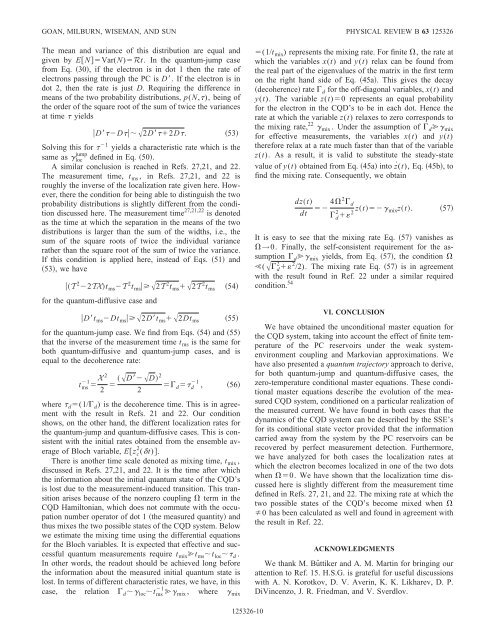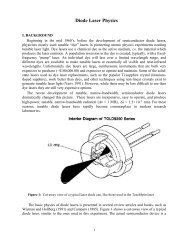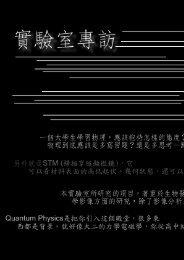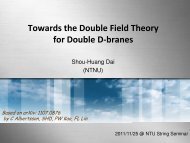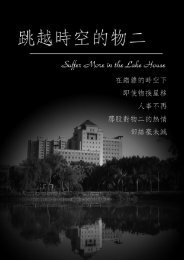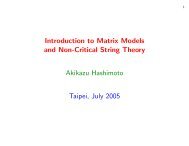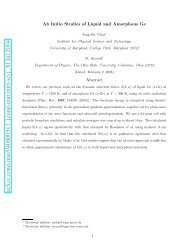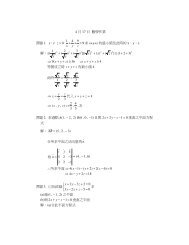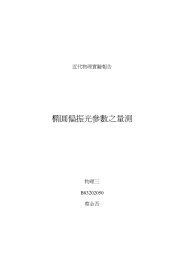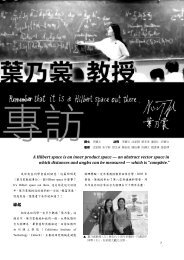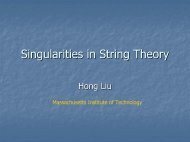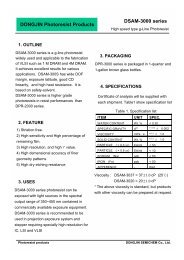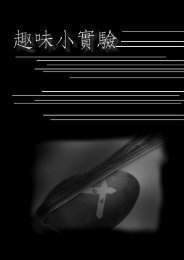Continuous quantum measurement of two coupled quantum dots ...
Continuous quantum measurement of two coupled quantum dots ...
Continuous quantum measurement of two coupled quantum dots ...
Create successful ePaper yourself
Turn your PDF publications into a flip-book with our unique Google optimized e-Paper software.
GOAN, MILBURN, WISEMAN, AND SUN PHYSICAL REVIEW B 63 125326where mixThe mean and variance <strong>of</strong> this distribution are equal and (1/t mix ) represents the mixing rate. For finite , the rate atgiven by ENVar(N)Rt. In the <strong>quantum</strong>-jump case which the variables x(t) and y(t) relax can be found fromfrom Eq. 30, if the electron is in dot 1 then the rate <strong>of</strong> the real part <strong>of</strong> the eigenvalues <strong>of</strong> the matrix in the first termelectrons passing through the PC is D. If the electron is in on the right hand side <strong>of</strong> Eq. 45a. This gives the decaycase, the relation d loc t ms mix , DiVincenzo, J. R. Friedman, and V. Sverdlov.dot 2, then the rate is just D. Requiring the difference in decoherence rate d for the <strong>of</strong>f-diagonal variables, x(t) andmeans <strong>of</strong> the <strong>two</strong> probability distributions, p(N,), being <strong>of</strong> y(t). The variable z(t)0 represents an equal probabilitythe order <strong>of</strong> the square root <strong>of</strong> the sum <strong>of</strong> twice the variances for the electron in the CQD’s to be in each dot. Hence theat time yieldsrate at which the variable z(t) relaxes to zero corresponds tothe mixing rate, 22 mix . Under the assumption <strong>of</strong> d mixDD2D2D. 53 for effective <strong>measurement</strong>s, the variables x(t) and y(t)Solving this for 1 yields a characteristic rate which is thesame as loc defined in Eq. 50.A similar conclusion is reached in Refs. 27,21, and 22.The <strong>measurement</strong> time, t ms , in Refs. 27,21, and 22 istherefore relax at a rate much faster than that <strong>of</strong> the variablez(t). As a result, it is valid to substitute the steady-statevalue <strong>of</strong> y(t) obtained from Eq. 45a into ż(t), Eq. 45b, t<strong>of</strong>ind the mixing rate. Consequently, we obtainroughly the inverse <strong>of</strong> the localization rate given here. However,there the condition for being able to distinguish the <strong>two</strong>probability distributions is slightly different from the conditiondiscussed here. The <strong>measurement</strong> time 27,21,22 42 ddztis denoteddt 2 d zt mixzt.2as the time at which the separation in the means <strong>of</strong> the <strong>two</strong>57distributions is larger than the sum <strong>of</strong> the widths, i.e., thesum <strong>of</strong> the square roots <strong>of</strong> twice the individual varianceIt is easy to see that the mixing rate Eq. 57 vanishes asrather than the square root <strong>of</strong> the sum <strong>of</strong> twice the variance.→0. Finally, the self-consistent requirement for the assumption d mix yields, from Eq. 57, the condition If this condition is applied here, instead <strong>of</strong> Eqs. 51 and53, we have( 2 d 2 /2). The mixing rate Eq. 57 is in agreementwith the result found in Ref. 22 under a similar requiredT 2 2TXt ms T 2 t ms 2T 2 t ms 2T 2 t ms 54 condition. 54for the <strong>quantum</strong>-diffusive case andDt ms Dt ms 2Dt ms 2Dt ms 55VI. CONCLUSIONWe have obtained the unconditional master equation forfor the <strong>quantum</strong>-jump case. We find from Eqs. 54 and 55the CQD system, taking into account the effect <strong>of</strong> finite temperature<strong>of</strong> the PC reservoirs under the weak system-that the inverse <strong>of</strong> the <strong>measurement</strong> time t ms is the same forboth <strong>quantum</strong>-diffusive and <strong>quantum</strong>-jump cases, and isenvironment coupling and Markovian approximations. Weequal to the decoherence rate:have also presented a <strong>quantum</strong> trajectory approach to derive,t ms X 22 DD 2for both <strong>quantum</strong>-jump and <strong>quantum</strong>-diffusive cases, the2d 1 d , 56 zero-temperature conditional master equations. These conditionalmaster equations describe the evolution <strong>of</strong> the measuredCQD system, conditioned on a particular realization <strong>of</strong>where d (1/ d ) is the decoherence time. This is in agreementwith the result in Refs. 21 and 22. Our condition the measured current. We have found in both cases that theshows, on the other hand, the different localization rates for dynamics <strong>of</strong> the CQD system can be described by the SSE’sthe <strong>quantum</strong>-jump and <strong>quantum</strong>-diffusive cases. This is consistentwith the initial rates obtained from the ensemble av-carried away from the system by the PC reservoirs can befor its conditional state vector provided that the informationerage <strong>of</strong> Bloch variable, Ez 2 c (t).recovered by perfect <strong>measurement</strong> detection. Furthermore,we have analyzed for both cases the localization rates atThere is another time scale denoted as mixing time, t mix ,which the electron becomes localized in one <strong>of</strong> the <strong>two</strong> <strong>dots</strong>discussed in Refs. 27,21, and 22. It is the time after whichthe information about the initial <strong>quantum</strong> state <strong>of</strong> the CQD’swhen 0. We have shown that the localization time discussedhere is slightly different from the <strong>measurement</strong> timeis lost due to the <strong>measurement</strong>-induced transition. This transitionarises because <strong>of</strong> the nonzero coupling term in thedefined in Refs. 27, 21, and 22. The mixing rate at which theCQD Hamiltonian, which does not commute with the occupationnumber operator <strong>of</strong> dot 1 the measured quantity and<strong>two</strong> possible states <strong>of</strong> the CQD’s become mixed when 0 has been calculated as well and found in agreement withthus mixes the <strong>two</strong> possible states <strong>of</strong> the CQD system. Belowthe result in Ref. 22.we estimate the mixing time using the differential equationsfor the Bloch variables. It is expected that effective and successful<strong>quantum</strong> <strong>measurement</strong>s require t mix t ms t loc d .In other words, the readout should be achieved long beforethe information about the measured initial <strong>quantum</strong> state islost. In terms <strong>of</strong> different characteristic rates, we have, in thisACKNOWLEDGMENTSWe thank M. Büttiker and A. M. Martin for bringing ourattention to Ref. 15. H.S.G. is grateful for useful discussionswith A. N. Korotkov, D. V. Averin, K. K. Likharev, D. P.125326-10


